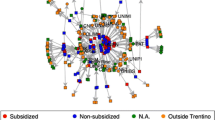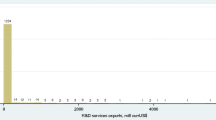Abstract
This research probes the configuration of technological systems in terms of inter-sectoral knowledge and intermediate goods exchanges based on a case study of 21 industry sectors in the economy of Malaysia. The case study draws on a network analysis of sectoral knowledge flows survey data and input–output exchange statistics. The results show that knowledge acquisition and dissemination networks are relatively more intra-sector, denser, and centralized than goods exchange networks, which can affect how innovations spread through the economy. Knowledge networks, however, are more likely to form sub-networks with potentially diverse capabilities and influence on the technological system. This adds new information and value for knowledge-based sectoral investment strategies.



Similar content being viewed by others
References
Beauchamp MA (1965) An improved index of centrality. Behavioral Science 10(2), 161–163.
Bergman EM and Feser EJ (1999) Industrial and Regional Clusters: Concepts and Comparative Applications Regional Research Institute. West Virginia University, Morganton, West Virginia.
Blacker F (1995) Knowledge, knowledge work and organizations: an overview and interpretation. Organization Studies 16(6), 1021–1046.
Blondel VD, Guillaume JL, Lambiotte R and Lefebvre E (2008) Fast unfolding of communities in large networks. Journal of Statistical Mechanics: Theory and Experiment 2008(10), P10008.
Bocquet R and Mothe C (2010) Knowledge governance within clusters: the case of small firms. Knowledge Management Research & Practice 8(3), 229–239.
Boschma R (2005) Proximity and innovation: a critical assessment. Regional Studies 39(1), 61–74.
Brusoni S, Prencipe A and Pavitt K (2001) Knowledge specialization, organizational coupling, and the boundaries of the firm: why do firms know more than they make? Administrative Science Quarterly 46(4), 597–621.
Cohen WM and Levinthal DA (1990) Absorptive capacity: a new perspective on learning and innovation. Administrative Science Quarterly 35(1), 128–152.
Chesbrough H (2003) Open Innovation: The New Imperative for Creating and Profiting from Technology. Harvard Business School Press, Cambridge, MA.
Department of Statistics Malaysia (2005) Input-Output Tables, Malaysia 2005. [WWW document] http://www.statistics.gov.my/portal/index.php?option=com_content&view=article&id=1242&Itemid=111&lang=en (accessed 2 March 2012).
Drejer I (1998) Technological Interdependence in the Danish Economy – a comparison of methods for identifying knowledge flows IKE group and DRUID, Department of Business Studies, Aalborg University, Aalborg, Denmark.
Economic Planning Unit (2001) The Third Outline Perspective Plan 2001–2010. Prime Minister’s Department, Putrajaya, Malaysia.
Edquist C (2006) Systems of innovation, perspectives, and challenges. In Oxford Handbook of Innovation (Fagerberg J, Mowery DC and Nelson RR, Eds), pp 77–95, Oxford University Press, Oxford.
Faust C and Wasserman S (1994) Social Network Analysis. Cambridge University Press, Cambridge.
Freeman LC (1977) A set of measures of centrality based on betweenness. Sociometry 40(1), 35–41.
Freeman LC (1978) Centrality in social networks conceptual clarification. Social Networks 1(3), 215–239.
Friedman T (2005) The World is Flat: A Brief History of the Twenty-First Century. Farrar, Straus and Giroux, New York.
Giroud A and Mirza H (2006) Factors determining supply linkages between transnational corporations and local suppliers in ASEAN. Transnational Corporations 15(3), 1–32.
Hage G and Meeus M (2006) Innovation, Science, and Institutional Change. Oxford University Press, New York.
IISC (2008) Study on Knowledge Content in Key Economic Sectors in Malaysia (Phase 2). Final Report. Submitted to the Economic Planning Unit, Prime Minister’s Department, Putrajaya, Malaysia by Intelligent Information Services Corporation, Atlanta.
ISIS (2002) Knowledge-Based Economy Master Plan. Institute of Strategic and International Studies, Kuala Lumpur, Malaysia.
Kash DE and Rycroft RW (2000) Patterns of innovating complex technologies: a framework for adaptive network strategies. Research Policy 29(7–8), 819–831.
Katila R and Ahuja G (2002) Something old, something new: a longitudinal study of search behavior and new product introduction. Academy of Management Journal 45(6), 1183–1194.
Knoke D and Yang S (2008) Social Network Analysis. SAGE Publications, Thousand Oaks, CA.
Kraaijenbrink J and Wijnhoven F (2008) Managing heterogeneous knowledge: a theory of external knowledge integration. Knowledge Management Research & Practice 6(4), 274–286.
Kraemer KL, Linden G and Dedrick J. (2011) Capturing value in global networks: Apple’s iPad and iPhone. [WWW document] http://pcic.merage.uci.edu/papers/2011/Value_iPad_iPhone.pdf (accessed 9 March 2014).
Liebowitz J (2008) ‘Think of others’ in knowledge management: making culture work for you. Knowledge Management Research & Practice 6(1), 47–51.
Lundvall B-AK (2010) National Systems of Innovation: Toward a Theory of Innovation and Interactive Learning. Anthem, London and New York.
March JG (1991) Exploration and exploitation in organizational learning. Organization Science 2(1), 71–87.
Madhavan R and Grover R (1998) From embedded knowledge to embodied knowledge: new product development as knowledge management. Journal of Marketing 62(4), 1–12.
Nambisan S and Sawhney M (2011) Orchestration processes in network-centric innovation: evidence from the field. Academy of Management Perspectives 25(3), 40–57.
Nelson RR (1993) National Systems of Innovation: A Comparative Study. Oxford University Press, Oxford.
Nold H (2011) Making knowledge management work: tactical to practical. Knowledge Management Research & Practice 9(1), 84–94.
Nonaka I and Takeuchi H (1995) The Knowledge-Creating Company: How Japanese Companies Create the Dynamics of Innovation. Oxford University Press, New York.
O’Reilly C and Tushman M (2004) The ambidextrous organization. Harvard Business Review 82(4), 74–81.
Petruzzelli AM, Albino V and Carbonara N (2009) External knowledge sources and proximity. Journal of Knowledge Management 13(5), 301–318.
Polanyi M (1966) The Tacit Dimension. University of Chicago Press, Chicago.
Porter ME (1990) The Competitive Advantage of Nations. Free Press, New York.
Rogers EM (2003) Diffusion of Innovations, 5th edn, Free Press, New York.
Rosenberg N (1982) Inside the Black Box: Technology and Economics. Cambridge University Press, Cambridge.
Rycroft RW and Kash DE (2004) Self-organizing innovation networks: implications for globalization. Technovation 24(3), 187–197.
Scott J (1991) Social Network Analysis. A Handbook. Sage, London.
Sena V (2004) The return of the prince of Denmark: a survey on recent developments in the economics of innovation. Economic Journal 114(496), F312–F332.
Shapira P, Youtie J, Yogeesvaran K and Jaafar Z (2006) Knowledge economy measurement: methods, results and insights from the Malaysian Knowledge Content Study. Research Policy 35(10), 1522–1537.
Shih H-Y and Chang P-L (2010) The application of network analysis to exploring intersectoral innovation flows: an alternative approach. International Journal of Business and Information 5(2), 91–110.
Teece DJ (1998) Competition, cooperation, and innovation: organizational arrangements for regimes of rapid technological progress. Journal of Economic Behavior and Organization 18(1), 1–25.
Waltman L, Van Eck NJ and Noyons ECM (2010) A unified approach to mapping and clustering of bibliometric networks. Journal of Informetrics 4(4), 629–635.
Wolff EN and Ishaq Nadiri M (1993) Spillover effects, linkage structure, and research and development. Structural Change and Economic Dynamics 4(2), 315–331.
Acknowledgements
This research draws on work undertaken in the project on Knowledge Content in Key Economic Sectors in Malaysia (Phase II) by Intelligent Information Systems Corporation and the Georgia Tech Technology Policy and Assessment Center for the Economic Planning Unit, Prime Minister's Department, Malaysia. Additional support for methodological development and publication of results was provided by the U.S. National Science Foundation (NSF) under Cooperative Agreement Numbers 0531184 and 0938099. Any opinions, findings, and conclusions or recommendations expressed in this material are those of the authors and do not necessarily reflect the views of the Economic Planning Unit or NSF.
Author information
Authors and Affiliations
Corresponding author
Rights and permissions
About this article
Cite this article
Kay, L., Youtie, J. & Shapira, P. Inter-industry knowledge flows and sectoral networks in the economy of Malaysia. Knowl Manage Res Pract 14, 280–294 (2016). https://doi.org/10.1057/kmrp.2014.30
Published:
Issue Date:
DOI: https://doi.org/10.1057/kmrp.2014.30




